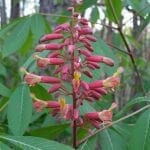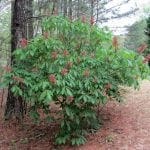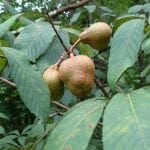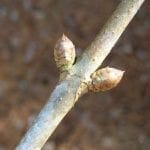- Inflorescence
- Overall plant habit
- Fruits (capsule with seeds inside)
- Winter twig
Scientific Name:
Aesculus pavia
Common Name:
Red buckeye
Scientific Name Pronounciation:
(ES-kew-lus PAY-vee-uh)
Plant Type:
Tree
Plant Hardiness Zones:
6-9
Plant Hardiness Zone(s):
Usual Size:
6-15 ft. H X 6-12 ft. W
Flower:
Flowers are 1 to 1.25 inches long, with four unequal, reddish petals and 6 or 7 shorter stamens; in upright branched clusters 4 to 6 inches long
Bloom Time Notes:
Spring
Leaf:
Deciduous; opposite; palmately compound leaves on slender leafstalk with 5 (sometimes 7) leaflets 4 to 6 inches long, 1.5 to 2 inches wide; finely sawtoothed; short stalked.
Fruit:
Capsule globe-shaped, smooth, light brown, and leathery; 1 to 1.5 inches in diameter; 1 to 4 seeds maturing in late summer
Wildlife:
Hummingbirds nectar on early flowers, bees visit flowers; small mammals eat seeds.
Natural Habitat:
Most often found on well-drained, open wooded slopes as understory plant.
Propagation:
Collect seed as soon as capsules begin to split in late summer; best grown from stratified seed in very early spring; protect seeds and very young plants from squirrels; seeds harvested in late summer and planted immediately into warm soil tend to germinate but might not be tough enough to survive a cold winter.
Bloom Time:
Sun or Shade:
Companion Plants:
Cultural Notes:
Large showy flowers; makes an excellent naturalizing plant; nectar source for hummingbirds. Grows best in rich, moist, but well-drained soil; if the usually red flowers are pale it might have hybridized with painted buckeye (Aesculus sylvatica).





